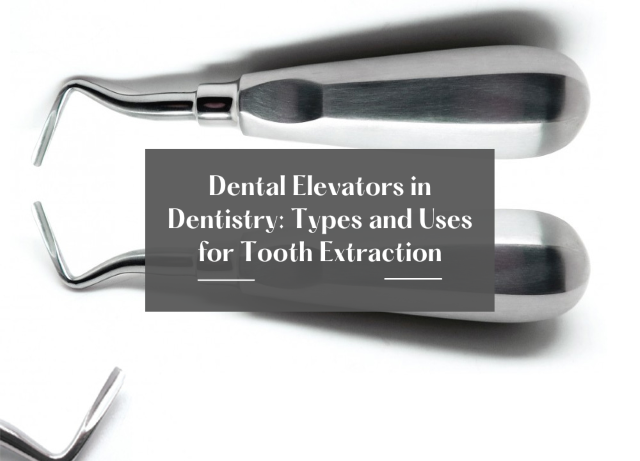Dental luxators and elevators are the vital instruments required in the dentistry field. Usually, they are used for tooth extraction purposes. They both look similar but have subtle differences. That is why both serve varying dental care purposes.
The dental elevators are thick and have fewer sharp edges. Its curved shoulder makes it ideal for deep-set tooth removal where more pressure is required on ligaments. On the other hand, dental luxators are slim in design and suitable for tooth extraction in hard-to-reach mouth areas.
Additionally, the elevators may not be as sharp as the luxators. However, they offer better longevity. Plus, extraction is the only viable method that doctors find suitable for less painful and traumatic treatment. Hence, they are switching to quality dental products like elevators to address the concerns with tooth loosening and provide the best oral health care to their patients.
In this article, we’ll go over what dental elevators are, how they work, and how they vary from luxators.
Overview of Dental Elevators
Dental elevators fall under the category of extraction tools and are designed to remove decayed or broken teeth from the socket. Varying elevator types are available depending on the working principle, shapes, and sizes.
Let us cover the types and their working principle below:
- Wedge: The easiest way of tooth extraction is by implementing the wedging principle. The elevator blade can be pushed in a rotation motion with a little force between the tooth and the alveolar bone.
- Fulcrum and Lever: Once the elevator blade wedging is over, the next step comes to putting the blade shank over the alveolar bone’s buccal. It is known as the fulcrum. The dentist will move the elevator in a downward direction with greater force after the fulcrum is set up.
- Axle and Wheel Principle: It is the advanced version of the lever principle. In this, the elevator’s handle works like an axle, and the tip is the wheel when performing a tooth removal procedure.
Different Types of Elevators
Straight Elevators
This type of elevator comprises a shank, a straight blade, and a handle. It could be either small in size or large. The edges of straight elevators come with a concave surface. However, it is only one side and which is usually placed towards the tooth that is to be removed.
Dentists can use small straight elevators when performing tooth luxation. On the other hand, the bigger ones are ideal for root displacement from the sockets and luxating teeth that are excessively spaced. Additionally, because the blade’s form can be angled about the shank, it can be used to address the mouth’s posterior aspects. It is easy to position between the teeth so that rotating movement occurs on the one that is to be extracted and no harm is done to the surrounding teeth.
Triangle Elevators
Triangle dental elevators are ideal to remove tough and broken teeth from the tooth socket. Usually, the mandibular molars get fractured. Thus, resulting in the medial root being left behind. Luckily, the elevators work in the axle and wheel direction removing the molar remnants from the socket.
Pick-Type Elevators
Engage root tips with pick-type elevators; the drill may also be necessary. Apex elevators, crane pick elevators, and pick-type elevator variations are some of the variations that can be used to remove deep root pieces. The dentists can position it between the root tip and the mouth’s socket wall. Thus, helping in extracting out the tough and tiny root tips.
Difference Between Dental Elevators and Luxator
Dental elevators have a little screwdriver appearance. They function as a bridge between the tooth and supporting mouth bone. Three parts make up a dental elevator: the handle, the blade, and the shank. Fractures of teeth are less likely when a dental elevator is used. There are many reasons dentistry professionals prefer elevators for tooth extractions. They can quickly remove root stumps and facilitate tooth socket expansion. Thus, making the tooth extraction process simple. Furthermore, elevators aid in separating the tooth-supporting tissues from the attachments. Furthermore,
On the other hand, to reduce the ligament holding the tooth in place, a luxator can be used in place of an elevator. The sole distinction is that luxators can’t be used as leverage because of their fragile working end. It is more delicate equipment for tooth removal from its socket and causes the least amount of tissue damage. Talking buying dentists can either buy a bone grafting kit comprising every essential tooth extraction tool. Or they can buy the elevators or luxators separately.
Conclusion
There may be many practitioners in the dentistry field not knowing about luxators or dental elevators. However, it is trending as the most demanding and quality dental product. When used rightly, both elevators and luxators help execute the least traumatic and most efficient tooth extraction.
Hence, this write-up is for dentists. This is because they need to know how elevators and luxators are different, what is their use, and on what principle they function. These are all important to deliver a comfortable and atraumatic tooth extraction experience to the patients.


